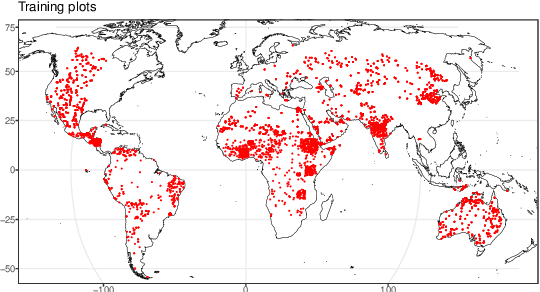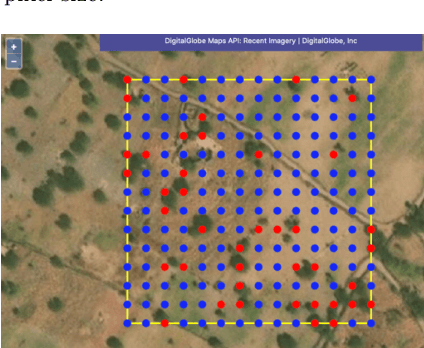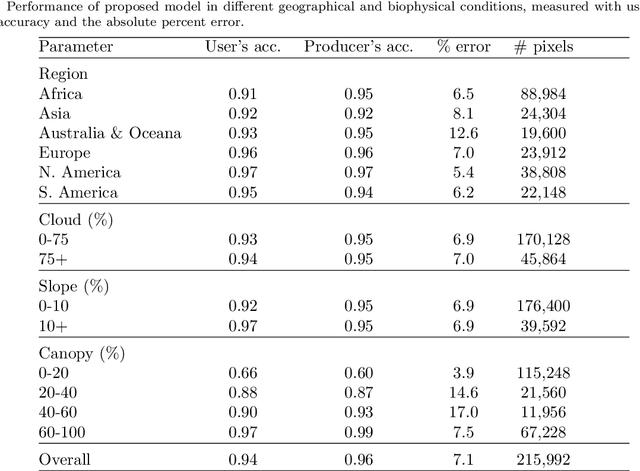Fred Stolle
A community palm model
May 01, 2024Abstract:Palm oil production has been identified as one of the major drivers of deforestation for tropical countries. To meet supply chain objectives, commodity producers and other stakeholders need timely information of land cover dynamics in their supply shed. However, such data are difficult to obtain from suppliers who may lack digital geographic representations of their supply sheds and production locations. Here we present a "community model," a machine learning model trained on pooled data sourced from many different stakeholders, to develop a specific land cover probability map, in this case a semi-global oil palm map. An advantage of this method is the inclusion of varied inputs, the ability to easily update the model as new training data becomes available and run the model on any year that input imagery is available. Inclusion of diverse data sources into one probability map can help establish a shared understanding across stakeholders on the presence and absence of a land cover or commodity (in this case oil palm). The model predictors are annual composites built from publicly available satellite imagery provided by Sentinel-1, Sentinel-2, and ALOS DSM. We provide map outputs as the probability of palm in a given pixel, to reflect the uncertainty of the underlying state (palm or not palm). The initial version of this model provides global accuracy estimated to be approximately 90% (at 0.5 probability threshold) from spatially partitioned test data. This model, and resulting oil palm probability map products are useful for accurately identifying the geographic footprint of palm cultivation. Used in conjunction with timely deforestation information, this palm model is useful for understanding the risk of continued oil palm plantation expansion in sensitive forest areas.
A global method to identify trees inside and outside of forests with medium-resolution satellite imagery
May 13, 2020



Abstract:Scattered trees outside of dense forests are very important for carbon sequestration, supporting livelihoods, maintaining ecosystem integrity, and climate change adaptation and mitigation. In contrast to trees inside of forests, not much is known about the spatial extent and distribution of scattered trees at a global scale. Due to the very high cost of high-resolution satellite imagery, global monitoring systems rely on medium resolution satellites to monitor land use and land use change. However, detecting and monitoring scattered trees with an open canopy using medium resolution satellites is difficult because individual trees often cover a smaller footprint than the satellites resolution. Here we present a globally consistent method to identify trees inside and outside of forests with medium resolution optical and radar imagery. Biweekly cloud-free, pansharpened 10 meter Sentinel-2 optical imagery and Sentinel-1 radar imagery are used to train a fully convolutional network, consisting of a convolutional gated recurrent unit layer and a feature pyramid attention layer. Tested across more than 215,000 Sentinel-1 and Sentinel-2 pixels distributed from -60 to +60 latitude, the proposed model exceeds 75 percent users and producers accuracy identifying trees in hectares with a low to medium density (less than 40 percent) of canopy cover, and 95 percent user's and producer's accuracy in hectares with dense (greater than 40 percent) canopy cover. When applied across large, heterogeneous landscapes, the results demonstrate potential to map trees in high detail and consistent accuracy over diverse landscapes across the globe. This information is important for understanding current land cover and can be used to detect changes in land cover such as agroforestry, buffer zones around biological hotspots, and expansion or encroachment of forests.
 Add to Chrome
Add to Chrome Add to Firefox
Add to Firefox Add to Edge
Add to Edge